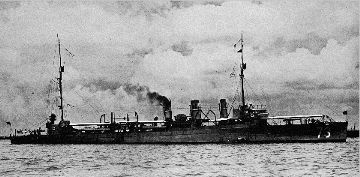

All but three flush-deckers had four stacks and two screws. DDs 71–73, Gwin, Conner and Stockton (shown) had three stacks; Conner and Stockton also had three screws.
Their hulls were designed to remedy weaknesses in the previous raised-forecastle classes, resulting in a “flush” weather deck, sloping continuously from bow to stern. They retained the same freeboard forward and aft as the “broken deckers” (as did the standardized mass-production destroyers of the following Wickes and Clemson classes).
The six Caldwells were designed for 18,500 shp and 30 knots, but differed from one another in other respects: Caldwell, Craven and Manley had four stacks; the others three. Conner and Stockton had three screws; the others two.
CALDWELL CLASS, 1916–1947

Their careers were also diverse. Keels were laid for four, beginning with Manley, in 1916. The other two were not laid down until after work had begun on the first Wickes-class ships. All were commissioned and served until 1922, when they were placed in reserve. Manley was recommissioned in 1930, while Caldwell and Gwin were stricken in 1936 and 1937 respectively.
The four surviving ships served in World War II. Manley became the first flush-decker converted as a high-speed transport (APD 1) The other three went to Britain in the destroyers-for-bases deal: Craven, her name having been dropped in 1935 in favor of a new Craven, was temporarily renamed Conway before entering service as HMS Lewes; Conner as HMS Leeds and Stockton as HMS Ludlow.